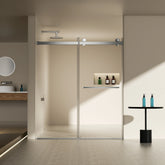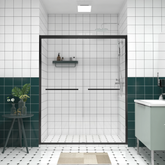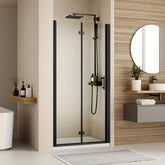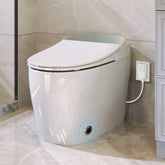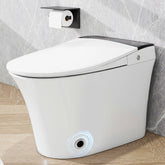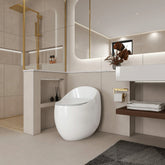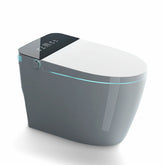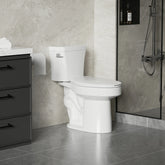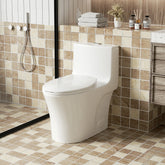Smart Toilets vs. Traditional Toilets: Is It Worth the Upgrade?
1. Introduction
It’s easy to overlook something as essential and everyday as a toilet—until it’s time for an upgrade. Over the years, toilet technology has quietly but significantly evolved. What used to be a purely functional bathroom fixture has now become a part of the growing smart home ecosystem. As a homeowner who recently started exploring options, I found myself asking: Should I stick with a traditional toilet or embrace the high-tech features of a smart toilet?
Smart toilets, once seen as luxury items in high-end hotels or futuristic homes, are becoming increasingly common in residential settings. With features like automatic flushing, heated seats, bidet functionality, air drying, and even self-cleaning systems, they promise to revolutionize our daily bathroom experience. But with all these advanced functions come higher costs and installation considerations.
So here’s the big question: Is a smart toilet worth the upgrade? In this article, I’ll walk through the key differences between smart toilets and traditional toilets, explore the benefits and drawbacks of each, and help you decide which one suits your lifestyle, budget, and bathroom goals best.

2. What is a Smart Toilet?
Before I started researching bathroom upgrades, I had a pretty basic idea of what a smart toilet was—something futuristic and probably too complicated for everyday use. But once I looked into it, I realized that a smart toilet isn’t just about flashy tech—it’s about comfort, hygiene, and convenience.
A smart toilet is an advanced version of a traditional toilet, designed with high-tech features that enhance the user experience. Some of the most common features include a built-in bidet function with adjustable water pressure and temperature, a heated seat for cold mornings, automatic flushing, a self-cleaning bowl, and even air dryers and deodorizers. Many models also offer night lights, motion sensors, and remote controls or app-based operation.
What surprised me most is how well these smart toilets integrate into modern smart homes. Just like a smart thermostat or smart lighting system, a smart toilet can be connected to your home’s network. Some models allow voice control through virtual assistants like Alexa or Google Assistant, while others offer usage tracking for health monitoring or water-saving optimization.
In short, a smart toilet is much more than just a high-tech novelty. It’s a step forward in bathroom design, combining hygiene, sustainability, and smart home compatibility into one sleek and functional fixture. And for anyone who values modern convenience, it’s definitely worth considering.

3. Key Differences Between Smart Toilets and Traditional Toilets
When I first started comparing smart toilets and traditional toilets, I didn’t realize how different they really were. It’s not just about buttons and electronics—everything from functionality to design leaps forward with smart technology. Here’s a breakdown of the key differences I discovered during my research.
Technology & Features
Traditional toilets are simple and mechanical—flush the handle, and that’s it. Smart toilets, on the other hand, are packed with advanced features like automatic flushing, heated seats, bidet spray functions, air drying, and even touchless lids. Some models include remote controls or mobile app connectivity, and a few integrate with smart home systems for voice activation or energy monitoring. The contrast in technology is striking, and it really changes how you interact with your bathroom space.
Hygiene & Comfort
Hygiene is where smart toilets truly shine. With built-in bidets and self-cleaning nozzles, they drastically reduce the need for toilet paper and manual cleaning. As someone who values cleanliness, I found these features incredibly appealing. Add to that a warm seat in the winter and a gentle air dry, and it’s clear that smart toilets bring a whole new level of comfort and luxury that traditional toilets simply can’t match.
Water Efficiency
Water-saving technology exists in both traditional and smart toilets, especially in dual-flush or low-flow models. However, many smart toilets go a step further with intelligent sensors that adjust flush volume based on use. Some even track usage data to help you conserve water over time. If you’re eco-conscious like me, this added efficiency is a big plus.
Installation Requirements
This was something I hadn’t initially considered. Traditional toilets are easy to install and usually require nothing more than a basic water supply. Smart toilets, however, often need an electrical connection and sometimes even a compatible plumbing setup. Depending on your bathroom, this might mean hiring a professional, which can increase the initial investment.
Design & Aesthetic Appeal
While traditional toilets come in various styles, they tend to follow a standard look. Smart toilets, on the other hand, are designed with sleek, modern aesthetics in mind. I noticed many models with minimalist shapes, concealed plumbing, and smooth surfaces that complement high-end bathroom decor. They’re not just functional—they're a design statement.
In the end, whether you prioritize technology, comfort, sustainability, or style, the differences between smart toilets and traditional toilets are clear. It really comes down to what matters most in your bathroom experience.

4. Pros and Cons of Smart Toilets
After diving into all the features and comparing them with traditional toilets, I realized that smart toilets bring a lot to the table—but they’re not without their downsides. If you’re like me, weighing the pros and cons is a crucial step before making any upgrade decision. Here’s what I found when evaluating smart toilets from both a practical and personal perspective.
Pros
✔️ Advanced Hygiene
One of the biggest reasons I started considering a smart toilet was its superior hygiene. The integrated bidet function, self-cleaning nozzles, and touchless flushing reduce contact and help maintain a cleaner bathroom environment. It’s a game-changer if you value personal cleanliness and want to limit the spread of germs.
✔️ Eco-Friendly and Water-Saving
I was pleasantly surprised to learn that many smart toilets are designed to be water-efficient. Some models use sensors to determine how much water is needed for each flush, saving significantly more water than traditional toilets. If you’re environmentally conscious or just want to lower your utility bills, that’s a major benefit.
✔️ Enhanced User Comfort
Let’s be honest—once you’ve experienced a heated seat, it’s hard to go back. Features like adjustable water temperature, air drying, deodorizing, and even night lights add a new level of comfort to your daily routine. It’s not just a toilet—it’s an experience.
✔️ Modern Design
Most smart toilets have a sleek, minimalist design that fits beautifully into contemporary bathrooms. The smooth lines and compact shape often make the space feel more refined and modern. For anyone updating a bathroom for aesthetic reasons, smart toilets absolutely stand out.
Cons
❌ High Upfront Cost
Here’s the first thing that gave me pause—smart toilets are significantly more expensive than traditional models. While prices vary, even basic smart toilets can cost several times more than a standard unit. It’s an investment, and you have to weigh whether the added features are worth the price.
❌ Installation Complexity
Unlike a traditional toilet, which is fairly straightforward to install, a smart toilet may require an electrical outlet and special plumbing. Depending on your current bathroom setup, this could mean extra installation costs or professional help, which adds to the total expense.
❌ Potential for Technical Issues
Technology is great—until it malfunctions. Because smart toilets include electronic components, there’s always a chance of software glitches or hardware failures. Regular toilets are more mechanical and generally more reliable over the long term with minimal maintenance.
❌ Dependence on Electricity
Since smart toilets rely on power to operate many of their functions, a power outage can limit their usability. While most models still allow manual flushing, features like the bidet or heated seat won’t work without electricity, which could be inconvenient depending on where you live.
For me, understanding these pros and cons helped clarify where a smart toilet fits into my lifestyle and budget. They’re not perfect—but for the right home and the right user, they can be a smart and satisfying upgrade.

5. Cost Comparison
One of the first questions I asked myself when considering a smart toilet was, “How much more is this going to cost me compared to a traditional toilet?” And to be honest, the difference is pretty noticeable—at least upfront. But when I looked deeper into the long-term value, the numbers started to make more sense.
Price Range: Smart Toilets vs. Traditional Toilets
Traditional toilets are generally budget-friendly. You can find a decent model for anywhere between $100 and $500, depending on the brand, features (like dual flush), and materials. Installation is usually straightforward and low-cost if your plumbing is standard.
Smart toilets, however, are a different story. Entry-level models start at around $800 to $1,200, while high-end versions with full features—such as a bidet, heated seat, air dryer, deodorizer, and remote control—can range from $2,000 to over $5,000. Add in potential electrical and plumbing upgrades, and the total cost can climb quickly.
Long-Term Value: Water Savings, Maintenance, and Durability
Despite the higher upfront investment, I found that smart toilets offer some long-term financial and lifestyle benefits. For starters, they’re designed to be more water-efficient, which can help lower your monthly water bill over time—especially if you’re switching from an older, high-flush toilet.
Another consideration is maintenance. Traditional toilets are simple, but that also means more frequent manual cleaning. Many smart toilets come with self-cleaning features, antimicrobial surfaces, and automatic flushing, which reduce the time and effort required for upkeep. That’s a small but meaningful quality-of-life improvement.
In terms of durability, both toilet types can last many years if properly maintained. However, smart toilets often include more advanced materials and build quality, which can translate into longer-lasting performance—though repairs may be more expensive if something goes wrong due to the electronics involved.
So yes, smart toilets are more expensive at the outset, but when I factored in the added convenience, hygiene, water savings, and potential home value boost, the upgrade started to feel more like a smart investment than just a luxury splurge.

6. Who Should Consider Upgrading?
After researching smart toilets in depth and even testing a few in showrooms, I began to realize that while they’re not a necessity for everyone, they do make a lot of sense for certain types of households. If you’re wondering whether a smart toilet is worth it for your lifestyle, here are a few situations where the upgrade pays off.
🏡 Households with Elderly or Disabled Family Members
If you live with aging parents or someone with limited mobility, a smart toilet can be a life-changing upgrade. Features like hands-free flushing, automatic lids, bidet functions, and air drying significantly reduce the need for physical movement and assistance. I saw how much easier it made things for a friend caring for a family member recovering from surgery. It’s about restoring dignity and comfort.
🏠 Luxury Home Upgrades
For those investing in modern or high-end home renovations, a smart toilet adds that final touch of sophistication. Alongside smart lighting, thermostats, and appliances, a sleek, feature-packed toilet completes the smart home experience. When I toured some newly built luxury homes, smart toilets were almost standard—and for good reason. They elevate the space both visually and functionally.
📱 Tech-Lovers & Early Adopters
If you enjoy exploring the latest in home tech (like I do), then a smart toilet is probably already on your radar. From voice-activated flushing to app-controlled seat temperatures, smart toilets offer plenty to tinker with. It's perfect for those who enjoy customizing every part of their living environment, right down to the bathroom experience.
🧼 People Prioritizing Hygiene and Convenience
Let’s face it—traditional toilets can be messy and inconvenient. If you’re someone who values a high standard of cleanliness and comfort, the features of a smart toilet are hard to ignore. Built-in self-cleaning functions, touchless controls, and advanced bidet systems all contribute to a much more hygienic routine. After trying one myself, I couldn’t believe how much more refreshed I felt compared to using a standard toilet.
So, if you fall into any of these categories—or even if you’re just someone who appreciates smart, efficient design—a smart toilet might be a worthy addition to your home. It’s not just about technology; it’s about enhancing daily life in small but meaningful ways.

7. Real-World User Experiences
While researching smart toilets, I didn’t just rely on specs and features—I wanted to know what actual users thought after making the switch from traditional toilets. I reached out to a few friends and scoured online reviews to hear directly from those who upgraded. Here are some of the most relatable and honest pieces of feedback I came across.
“It completely changed how I feel about bathroom hygiene.”
Emma, a mom of two in California, told me that installing a smart toilet was one of the best decisions she made during her recent bathroom remodel. “The built-in bidet and air dry features keep things much cleaner, especially for the kids. I honestly can’t imagine going back to toilet paper,” she said. For her, the upgrade wasn’t about luxury—it was about practicality and hygiene.
“It felt excessive at first—until I used it.”
Daniel, a self-proclaimed minimalist in New York, admitted he thought smart toilets were a gimmick. “But once I tried one at a hotel, I was hooked,” he laughed. “The heated seat, the automatic lid—it just made everything feel more thoughtful and comfortable. I ended up buying one during a home upgrade, and I don’t regret it.”
“A game-changer for my elderly father.”
Samantha from Texas shared how installing a smart toilet for her aging father made caregiving easier. “He has limited mobility, and the touchless flushing, bidet, and drying functions have restored a bit of his independence. It’s more than a convenience—it’s been a real improvement in quality of life.”
“Yes, it’s expensive. But it feels worth it every single day.”
Mark, a tech enthusiast in Seattle, said he budgeted specifically for a smart toilet during his smart home renovation. “I know it’s a high upfront cost, but honestly, I use this thing every day. The features, the sleek design—it makes my bathroom feel like a spa. It’s the kind of upgrade that quietly makes your life better.”
These real-world experiences helped me realize that smart toilets aren’t just about advanced features—they’re about enhancing everyday comfort, cleanliness, and even independence. For many people, the benefits truly outweigh the cost.

8. Final Verdict: Is It Worth It?
After researching, comparing, and even trying out a few smart toilets myself, I’ve come to a balanced conclusion: yes, smart toilets are worth the upgrade—but not for everyone.
On the one hand, the benefits are hard to ignore. Smart toilets offer advanced hygiene features like built-in bidets and self-cleaning systems, eco-friendly water usage, and enhanced comfort through heated seats, air dryers, and touchless operation. They also elevate the overall bathroom experience with modern aesthetics and seamless integration into smart home systems.
On the other hand, these perks come at a cost. The high upfront price, potential installation complexity, and dependence on electricity can be deal-breakers for some. If you're on a tight budget or prefer simplicity over high-tech convenience, a well-designed traditional toilet can still meet your needs just fine.
So, when is it worth upgrading?
- ✅ If you value hygiene and hands-free comfort
- ✅ If you're doing a luxury home remodel
- ✅ If someone in your home needs mobility support
- ✅ If you’re a tech lover or early adopter
When a traditional toilet is enough:
- ✔️ You’re on a tight renovation budget
- ✔️ You prefer simple functionality without electronics
- ✔️ Your home setup doesn’t easily support electrical upgrades
For me personally, once I experienced the comfort and cleanliness of a smart toilet, I saw it less as a luxury and more as a long-term investment in daily well-being. If that sounds like something you value too, the upgrade just might be worth every penny.

9. Conclusion
Now that I’ve explored the ins and outs of smart toilets vs. traditional toilets, one thing is clear—this upgrade is about more than just technology. It’s about enhancing everyday comfort, improving personal hygiene, and adding lasting value to your home.
From heated seats and bidet functions to water-saving features and sleek, modern design, smart toilets are built to deliver a level of convenience that traditional toilets simply can’t match. Yes, the upfront cost may be higher, but when I considered the long-term benefits—less maintenance, improved cleanliness, and greater accessibility—the investment felt justified.
If you’re planning a bathroom renovation or just want to modernize your space, I highly recommend looking into smart toilet models. There are options for a variety of needs and budgets, whether you want a fully integrated system or a smart bidet seat attachment. And if you’re not sure where to start, consulting a bathroom design professional can help you find the perfect match for your lifestyle and home setup.
In the end, it’s not just about flushing differently—it’s about living more comfortably, cleanly, and intelligently. And for me, that makes all the difference.
Featured Products
AISU Smart Bidet Toilet with Remote Control.Raised Tankless Toilet with LED Display
- $515.62
- $515.62
- Unit price
- / per
AISU One Piece Heated Seat Smart Toilet, White
- $357.77
- $357.77
- Unit price
- / per
AISU Smart Toilet with Foot Sensor Flush, Blue Night Light, White
- $361.95
- $361.95
- Unit price
- / per
AISU One-Piece 1.28 GPF Single Flush Egg Shape Toilet
- from $474.56
- from $474.56
- Unit price
- / per
-
Glossy White
-
Glossy Black
AISU Smart Toilet with Heated Bidet Seat, Portable toilet with bidet built in AUTO Open&Close, AUTO Dual Flush, Bidet toilet with Dryer and Warm Water, White
- $635.27
- $635.27
- Unit price
- / per
AISU 1.28 GPF Tornado Flush Two-piece Toilet for bathrooms, Siphonic Side Press Single Flush, 17"ADA Comfort Chair Height Seat, S-trap 12", Rimless Bowl with Soft Closing Seat, Easy-to-Use, Gloss White
- $229.84
- $229.84
- Unit price
- / per
AISU 1.1/1.6 GPF Tornado Flush One-Piece Toilet Elongated, Siphonic S-trap 12", Soft Closing Seat, Button on Tank top, Powerful Dual Flush MAP 1000g, Comfort Chair Seat ADA Height 17", Glossy White
- $316.17
- $316.17
- Unit price
- / per
